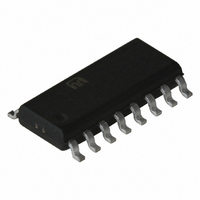MIC2560-1BWM Micrel Inc, MIC2560-1BWM Datasheet - Page 7

MIC2560-1BWM
Manufacturer Part Number
MIC2560-1BWM
Description
IC PCMCIA CARD SW MATRIX 16-SOIC
Manufacturer
Micrel Inc
Type
PCMCIA/Cardbus Switchr
Datasheet
1.MIC2560-1YWM.pdf
(8 pages)
Specifications of MIC2560-1BWM
Number Of Outputs
2
Rds (on)
1 Ohm
Internal Switch(s)
Yes
Current Limit
200mA
Voltage - Input
3.3V, 5V, 12V
Operating Temperature
-40°C ~ 85°C
Mounting Type
Surface Mount
Package / Case
16-SOIC (0.300", 7.5mm Width)
Lead Free Status / RoHS Status
Contains lead / RoHS non-compliant
Available stocks
Company
Part Number
Manufacturer
Quantity
Price
Company:
Part Number:
MIC2560-1BWM
Manufacturer:
SHARP
Quantity:
1 310
Part Number:
MIC2560-1BWM
Manufacturer:
MICREL/麦瑞
Quantity:
20 000
compatible with and desires a different V
controller commands this change by disabling V
waiting at least 100ms, and then re-enabling the other
V
If no card is inserted or the system is in sleep mode, the
controller outputs a (V
MIC2560, which shuts down V
switch into a high impedance output shutdown (sleep)
mode, where current consumption drops to nearly zero,
with only tiny CMOS leakage currents flowing.
During Flash memory programming with standard
(+12V) Flash memories, the PCMCIA controller outputs
a (1,0) to the EN0, EN1 control pins of the MIC2560,
which connects V
of the MIC2560 switches allow using small bypass
capacitors (in some cases, none at all) on the V
and V
by a large filter capacitor on the input supply voltage to
V
sufficient). The V
typically takes 250µs. After programming is completed,
the controller outputs a (EN1, EN0) = (0,1) to the
MIC2560, which then reduces V
read verification. Break-before-make switching action
reduces switching transients and lowers maximum
current spikes through the switch from the output
capacitor. The flag comparator prevents having high
voltage on the V
V
until V
lockout delay time varies with the load current and the
capacitor on V
I
Internal drive and bias voltage is derived from V
Internal device control logic is powered from V
Input logic threshold voltages are compatible with
common PCMCIA controllers using either 3.3V or 5V
supplies. No pull-up resistors are required at the control
inputs of the MIC2560.
Output Current and Protection
MIC2560 output switches are capable of more current
than needed in PC Card applications (1A) and meet or
exceed all PCMCIA specifications. For system and card
protection, output currents are internally limited. For full
system protection, long term (millisecond or longer)
output short circuits invoke overtemperature shutdown,
protecting the MIC2560, the system power supplies, the
card socket pins, and the memory card. Overtemp-
erature shutdown typically occurs at a die temperature of
115°C.
Single V
For PC Card slots requiring only a single V
V
(i.e., Pins 1, 3, and 15 are all connected to system V
PP OUT
Micrel, Inc.
September 2006
CC
PP IN
CC
CC3 IN
voltage.
inputs, by disabling the low voltage V
PP OUT
, the delay is approximately 250µs.
(usually the main power supply filter capacitor is
PP OUT
and V
CC
Operation
pins, with the main filtering action performed
CC5 IN
drops below the V
PP OUT
PP OUT
PP IN
PP OUT
together and to the system V
. With a 0.1µF capacitor and nominal
to V
capacitor from contaminating the
CC3 IN
transition from V
PP OUT
, V
CC
PP OUT
. The low ON resistance
CC5 IN
CC
. This also places the
level selected. The
to the V
) = (0,0) to the
CC
CC
PP
CC
CC
level, the
, connect
CC
to 12.0V
switches
level for
supply
CC OUT
CC3 IN
PP IN
CC
CC
).
,
.
.
7
Either the V
enable the card slot V
preferred because of its lower ON resistance.
Suspend Mode
An additional feature in the MIC2560 is a pseudo power-
down mode, Suspend Mode, which allows operation
without a V
supplies 3.3V to V
is enabled by the PCMCIA controller. This mode allows
the system designer the ability to turn OFF the V
supply generator to save power when it is not specifically
required. The PCMCIA card receives V
capacity during Suspend Mode, as the switch resistance
rises to approximately 4.5Ω.
High Current V
Figure 5 shows the MIC2560 with V
provided by a simple charge pump. This enables the
system designer to achieve full V
a +12V supply, which is often helpful in battery powered
systems that only provide +12V when it is needed.
These on-demand +12V supplies generally have a
quiescent current draw of a few milli-amperes, which is
far more than the microamperes used by the MIC2560.
The charge pump of figure 5 provides this low current,
using about 100µA when enabled. When V
selected, however, the on-demand V
be used, as this charge pump cannot deliver the current
required for Flash memory programming. The Schottky
diode may not be necessary, depending on the
configuration of the on-demand +12V generator and
whether any other loads are on this line.
Figure 5. Circuit for Generating Bias Drive for the V
Switches when +12V is Not Readily Available.
PP IN
CC5
switch or the V
CC
supply. In Suspend Mode, the MIC2560
Operation Without a +12V Supply
CC OUT
CC
whenever a V
; generally the V
CC3
CC
switch may be used to
performance without
PP
CC
CC
generator must
M9999-092106
CC
output of 3.3V
PP OUT
CC3
switch bias
at reduced
MIC2560
switch is
=12V is
CC
PP










